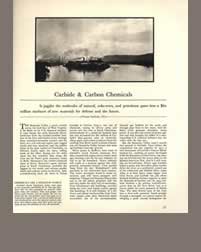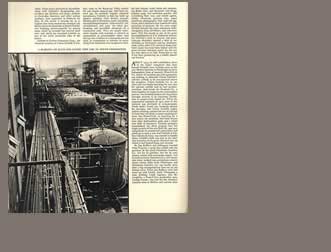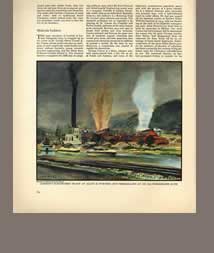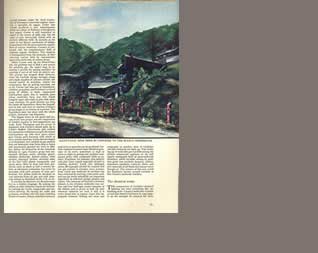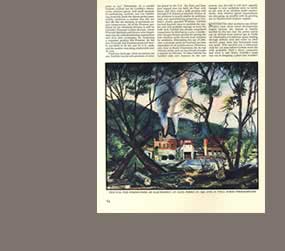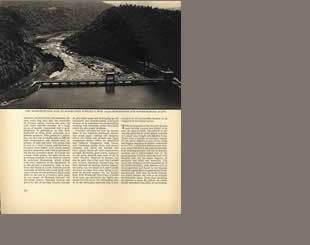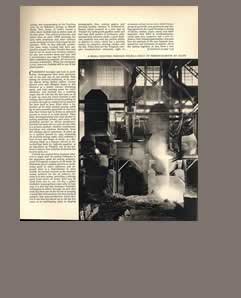In an interview, Adams described
working under severe time pressures for FORTUNE, taking two weeks, day
and night, when he needed months. Taking the photograph of the electrical
furnace in volcanic conditions, he was dressed by the company in an asbestos
suit with an asbestos shield for his camera. Elsewhere Adams reveals
how inaccurate were many of FORTUNE's industrial features. He saw the
magazine as a vehicle for its advertisers. There are other fascinating
details of working for FORTUNE at
 FULL
TEXT An
Interview with Ansel Adams Conducted by Ruth Teiser and Catherine Harroun
in 1972, 1974, and 1975, THE BANCROFT LIBRARY,
THE UNIVERSITY OF CALIFORNIA FULL
TEXT An
Interview with Ansel Adams Conducted by Ruth Teiser and Catherine Harroun
in 1972, 1974, and 1975, THE BANCROFT LIBRARY,
THE UNIVERSITY OF CALIFORNIA
"Several things I did for Fortune were preliminary
in anticipation of the war. I never realized it until later. But the people
who knew just said, "We're going to be in this, and we'd better get
ready." I
photographed [for Fortune] the big electric furnaces of Union Carbide in
the town of Alloy [West Virginia]. Unbelievable. I don't know how they
work them now, but the electrodes carbon arcs a single arc three feet in
diameter, nine feet long, and three of them are screwed together. They
were cast with threads, so they'd be screwed together into a single arc
twenty-seven feet high carbon. And they would be grouped together in threes,
operated by hydraulic controls, and the cauldron was as big as this whole
place forty feet across. The voltage was only six volts, but it would have
a tremendous amperage. And the current comes in in folds of copper not
wires, but just thick bands ribbons of copper. Well, anyway, these great
carbon electrodes come down into this mix slowly come down and make the
contact, and it's just like a volcano! It displays absolutely tremendous
power. They had a hydroelectric plant just for that purpose in that area.
Now, getting back to this photography for Fortune , the
photography of the electric furnaces at the town of Alloy, which is up
the Kanawha River. I described these great electrodes, which were three
feet across and twenty-seven feet long three of them bunched together.
And the tremendous amount of electric power required. And when these things
touched the mix (I think they call it the mix), it's something like a volcano.
And they keep burrowing in, and producing tremendous heat. And finally
the material starts to melt. It is steel and various alloy chemicals making
up certain crucial alloy metal. Nobody is supposed to be in that place
when the contact is made, because it'd be like being on Mount Etna during
an eruption, you see. Well, I said I had to be there to make the photograph.
So they made me an asbestos garment, and they made an asbestos shield for
the camera. And I would stand there under the shield with my hand on the
cable release, you see. One could see just the lens and my goggles. When
the process began, I thought, "What am I doing here?" Pieces
of molten metal were coming at you. And after about five minutes of this
it quiets down and just starts to melt, and then finally the carbon arcs
are used up. You see them dropping, slowly dropping into this incredible
blue-white heat. I forget the temperatures. I think it was over 4000. It's
one of the highest temperatures used in metallurgy. I wouldn't want to
state it erroneously.
Anyway, when they pour this "melt," it's blinding blue-white.
And it runs out like water that seems much lighter than any water you have
seen. It just pours out through the channels and you have to wear goggles.
You can't possibly look directly at it. And they'd make these big ingots,
and they go off to the mills. "
|





